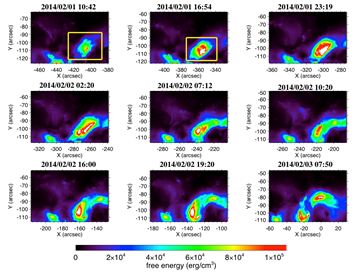NLFFF calculation of the solar coronal magnetic field based on Hinode observations
JAXA Supercomputer System Annual Report April 2016-March 2017
Report Number: R16E0117
- Responsible Representative: Masaki Fujimoto(Institute of Space and Astronautical Science, Department of Solar System Sciences)
- Contact Information: Toshifumi Shimizu(shimizu.toshifumi@jaxa.jp)
- Members: Yusuke Kawabata, Yumi Bamba, Toshifumi Shimizu, Takahiro Hasegawa, Takafumi Doi
- Subject Category: Space(Space science)
Abstract
Our study focuses on understanding of the mechanism responsible for the occurrence of the solar flares. We derive 3D magnetic field structure in the corona by performing a 3D magnetohydrodynamics simulation using vector magnetic field map acquired with the Hinode spacecraft. We investigate the relation between 3D magnetic field structure and the occurrence of solar flares.
Goal
We aim to investigate the relation between the three-dimensional magnetic field structure and the occurrence of solar flares. We assume that the solar atmosphere satisfy the force-free condition and estimate the three-dimensional magnetic field in the corona.
Objective
Our goal is to understand the relation between the occurrence of flares and three-dimensional magnetic field structure by using vector magnetic field map measured with the Hinode spacecraft.
References and Links
N/A
Use of the Supercomputer
We perform 3D magnetohydrodynamics numerical simulation by using vector magnetic field data acquired with the Hinode spacecraft in order to infer 3D magnetic field structure in the corona.
Necessity of the Supercomputer
We need large computational resource in order to perform three-dimensional magnetohydrodynamics simulation.
Achievements of the Year
We performed the 3D MHD calculation to infer the 3D magnetic field in the corona by using the vector magnetic field maps in the solar surface observed with the Hinode spacecraft. Based on the inferred coronal field data, we investigated the temporal evolution of the spatial distribution of the free energy stored in the corona. Figure 1 shows the energy density distribution averaged along the vertical direction in the active region as a function of time. We revealed that the sufficient energy for producing solar flares were stored more than 10 hours before the occurrence of the flare (yellow rectangle).

Fig.1:The temporal evolution of the spatial distribution of magnetic free energy stored in an active region. The energy increase can be seen in the area specified by yellow rectangle
Publications
Presentations
1) Shimizu, T. ‘Recent progress in understanding solar flares and activities with Hinode observations’ (invited lecture), 2015 ISEE workshop ‘International GEMSIS and ASINACTR-G2602 Workshop: Future Perspectives of Researches in Space Physics’, 22-25 March 2016, Nagoya University, Nagoya.
2) Shimizu, T. ‘Magnetic twist in solar coronal magnetic fields and fast reconnection,’ (invited lecture) US-Japan Workshop on Magnetic Reconnection, 7-11 March 2016, Napa, USA.
3) Shimizu, T. ‘Hinode in PSTEP program,’ Hinode seminar, 22 June 2016, ISAS, Sagamihara, Japan.
Computational Information
- Parallelization Methods: Process Parallelization
- Process Parallelization Methods: MPI
- Thread Parallelization Methods: n/a
- Number of Processes: 144
- Number of Threads per Process: 1
- Number of Nodes Used: 12
- Elapsed Time per Case (Hours): 5
- Number of Cases: 9
Resources Used
Total Amount of Virtual Cost(Yen): 535,452
Breakdown List by Resources
| System Name | Amount of Core Time(core x hours) | Virtual Cost(Yen) |
|---|---|---|
| SORA-MA | 0.16 | 0 |
| SORA-PP | 1,558.03 | 13,302 |
| SORA-LM | 0.00 | 0 |
| SORA-TPP | 29,665.06 | 437,411 |
| File System Name | Storage assigned(GiB) | Virtual Cost(Yen) |
|---|---|---|
| /home | 43.46 | 397 |
| /data | 430.76 | 3,940 |
| /ltmp | 8,789.07 | 80,399 |
| Archiving System Name | Storage used(TiB) | Virtual Cost(Yen) |
|---|---|---|
| J-SPACE | 0.00 | 0 |
Note: Virtual Cost=amount of cost, using the unit price list of JAXA Facility Utilization program(2016)
JAXA Supercomputer System Annual Report April 2016-March 2017


